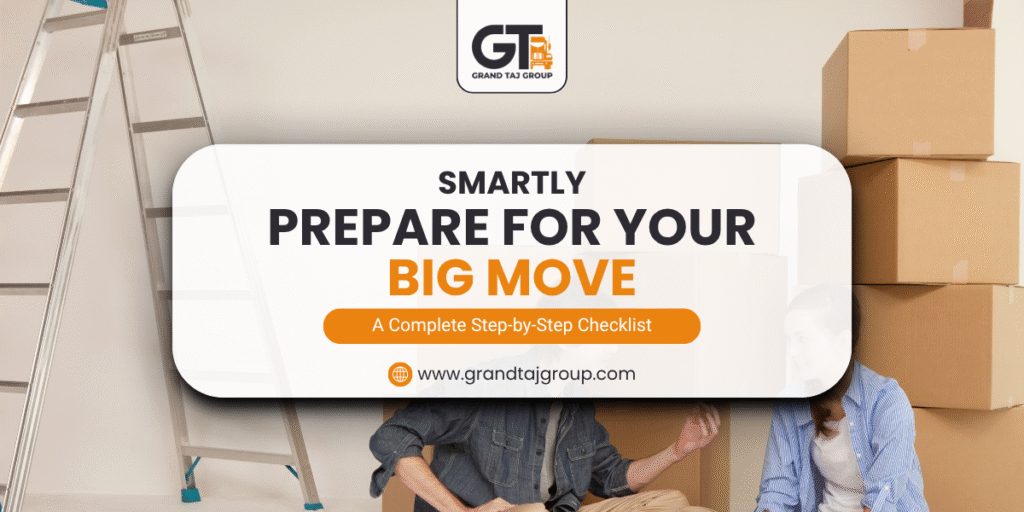You’ve just signed the lease (or closed the deal) on your new place in Connecticut.
Excitement kicks in, but so does the stress. Boxes are piling up, your to-do list keeps growing, and suddenly, moving day feels way too close for comfort.
Sound familiar?
Whether you’re relocating to a cozy coastal town like Mystic or settling into a bustling city like Stamford, moving in Connecticut can be smoother with the right plan.
Here’s your ultimate step-by-step checklist to make the transition easier, faster, and almost enjoyable.
Step-by-Step Checklist to Prepare for a Move in Connecticut
Relocating isn’t always easy, but it’s totally doable with a little bit of preparation and planning. If you want your move to go off without a hitch in 2025, Grand Taj Group has you covered with its comprehensive moving checklist. These pointers can help you remain organised whether you’re relocating across town in Connecticut or across the country.
Start Early
One of the most effective ways to ensure a smooth and stress-free move is to start preparing as early as possible. Ideally, begin planning at least 8 weeks before your move date. This early start gives you enough time to tackle the process in manageable steps.
You can begin by creating a moving checklist, sorting through each room, and deciding what to keep, donate, sell, or discard. Starting early also allows you to book reliable movers, gather packing supplies gradually, and avoid the anxiety that comes with last-minute packing and forgotten tasks.
Create a Moving Binder
When you’re in the middle of a move, it’s easy for things to get scattered, receipts tucked into pockets, contracts buried in emails, and to-do lists scribbled on random scraps of paper. That’s where a moving binder becomes a game-changer.
A moving binder is your central hub for everything related to your move. It helps you stay organized and ensures that you’re not scrambling at the last minute to find an important document.
What to include in your moving binder:
- Moving company contracts and estimates
- Inventory checklists for each room
- Receipts for deposits, packing supplies, and services
- Copies of your change-of-address confirmation
- Floor plans or measurements for the new home
- Utility setup and disconnection schedules
- A daily or weekly moving timeline
Scenario Example:
Imagine you’re moving across the state and you’ve hired a moving company. On moving day, the team asks for a copy of the contract before unloading, but you can’t remember if it was emailed or printed. You waste 30 minutes searching your phone, email inbox, and car dashboard.
Now, imagine if you had created a moving binder. You simply flip open the “Moving Company” section, hand them a copy of the signed agreement, and everything proceeds smoothly. No stress, no delay.
A well-organized moving binder saves you time, keeps your head clear, and ensures you’re ready for any situation during the move.
Set a Realistic Budget
Moving isn’t just about packing boxes; it comes with a variety of expenses that can quickly add up if you’re not prepared. Setting a realistic budget is one of the most important steps in ensuring a smooth and financially stress-free move.
Start with the Basics
List all the potential costs involved in your move. These may include:
- Moving company fees or truck rental costs
- Packing supplies (boxes, bubble wrap, tape, labels)
- Utility deposits and connection/disconnection fees
- Cleaning services for the old and/or new home
- Temporary storage (if there’s a gap between move-out and move-in)
- Gas, tolls, and meals during the move (especially if long-distance)
- Pet or childcare on moving day (if needed)
Add at least 10–15% as a buffer for unexpected costs. Things like needing extra boxes, furniture damage, or last-minute moving help can happen, and a buffer helps you stay calm and covered.
Research Moving Companies in Connecticut
Choosing the right moving company is one of the most critical steps in the relocation process. The wrong choice can lead to damaged belongings, delays, or hidden fees, so it’s important to do your homework well in advance.
Start with Licensed and Insured Movers
Begin your search by ensuring the companies you’re considering are properly licensed and insured. In Connecticut, local movers should be registered with the Connecticut Department of Transportation (CTDOT). For interstate moves, make sure the company is registered with the Federal Motor Carrier Safety Administration (FMCSA) and has a valid USDOT number.
A licensed and insured mover not only ensures your belongings are protected but also gives you legal recourse in case anything goes wrong.
Read Reviews and Ask Around
Online reviews can give you real insight into a company’s reliability. Check platforms like:
- Google Reviews
- Better Business Bureau (BBB)
- Yelp
Look for companies that consistently receive positive feedback for punctuality, professionalism, and care with belongings. It also helps to ask friends, family, or coworkers if they’ve had good experiences with a local mover.
Compare Multiple Quotes
Don’t settle for the first estimate you get. Instead, request in-home or virtual quotes from at least three different companies. This allows you to:
- Compare pricing
- Understand what services are included (e.g., packing, loading, unloading)
- Identify hidden fees (e.g., fuel charges, stair fees, or long-carry fees)
Consider the Grand Taj Group
Among the top-rated movers in Connecticut, The Grand Taj Group stands out for its professionalism, transparent pricing, and customer-first approach. Fully licensed and insured, they meet all CTDOT and FMCSA requirements, ensuring your move is handled with the utmost care and compliance.
What sets Grand Taj Group apart is its commitment to making the moving experience stress-free. From offering detailed quotes with no hidden fees to providing optional packing, unpacking, and storage solutions, they tailor their services to meet your specific needs.
With glowing reviews across platforms like Google and the BBB, and a reputation for punctuality and careful handling, Grand Taj Group is a reliable choice whether you’re moving across town or state lines.
Declutter Your Home
Before you start packing, take time to go through every room in your home and sort your belongings. Separate items into categories: what you want to keep, donate, sell, or discard. Be honest about what you really use and need; this is your chance to let go of things that no longer serve a purpose.
Decluttering not only makes the moving process more manageable, but it also reduces the volume of items to pack and transport. Fewer boxes mean lower moving costs and less time spent loading and unloading. It also helps you stay organized and settle into your new home more quickly.
Start Packing Room-by-Room
To avoid feeling overwhelmed, start your packing process one room at a time. Begin with non-essential spaces, like guest rooms, basements, or seasonal storage, where items aren’t used daily. This allows you to make steady progress without disrupting your daily routine.
Use sturdy boxes and label each one with its contents and the room it belongs to. This will make unpacking much easier later. For fragile items, use bubble wrap or packing paper to cushion them properly, and clearly mark those boxes as “Fragile” to ensure careful handling. This methodical approach helps keep your move organized and stress-free.
Notify Utility and Service Providers
As your move date approaches, it’s important to contact all your utility and service providers well in advance. This includes electricity, gas, water, internet, cable, trash collection, and any home security systems you may have.
Let them know the exact date you’ll be moving out, and schedule a service disconnection for that day. At the same time, arrange for these services to be connected at your new address on or before your arrival. Doing this ahead of time helps prevent any disruption in essential services and ensures a smooth transition into your new home.
Update Your Address
Once your moving date is finalized, updating your address should be high on your to-do list. Start by submitting a change of address request with the United States Postal Service (USPS) so your mail gets forwarded to your new home.
Next, update your address with all important institutions, including:
- Banks and credit card companies
- Insurance providers (health, auto, home, etc.)
- Healthcare providers
- Subscription services (magazines, meal kits, streaming services, etc.)
If you’re staying within Connecticut, don’t forget to update your driver’s license and voter registration as well. Keeping your information current ensures you continue receiving bills, benefits, and services without interruption.
Prepare an Essentials Box
During the chaos of moving, it’s easy to misplace things you need right away. That’s why packing an essentials box is so helpful. This box should include everything you’ll need during the first 24–48 hours in your new home, such as:
- Toiletries (toothbrush, soap, toilet paper)
- Medications
- A change of clothes
- Important documents (IDs, lease, medical records)
- Phone chargers and basic electronics
- Basic kitchenware (cups, plates, utensils)
- Snacks and water
- Bed linens or a blanket
Keep this box with you during the move rather than putting it in the moving truck. It will save you from digging through boxes on your first night.
Confirm Moving Day Details
As moving day approaches, make sure all details are finalized and confirmed. Call your moving company at least 24–48 hours in advance to verify:
- Arrival time
- Pickup and drop-off addresses
- Any special instructions (e.g., fragile items, narrow staircases, elevator access)
Also, check that your new home is ready for the move:
- Is the building accessible?
- Do you need to reserve a freight elevator or parking space?
- Are there any restrictions for moving in (like time slots in apartment buildings)?
Clear communication with your movers and proper coordination will help your move go smoothly and reduce any last-minute stress.
Hire Professional Movers
If you want your relocation to be completely hassle-free, think about hiring movers like Grand Taj Group. From packing and loading to storage and transporting to unpacking, our crew is well-versed in every facet of residential and business moves.
Let’s Wrap
Preparing for a move in Connecticut isn’t something that happens overnight. It requires careful planning, organization, and attention to detail. But when you break it down into manageable steps, like the ones outlined in this checklist, the entire process becomes less overwhelming.
From budgeting and packing to updating your address and confirming logistics, each task plays an important role in ensuring a smooth transition. The key is to start early, stay organized, and tackle one step at a time.
By the time moving day arrives, you’ll feel prepared, in control, and ready for this exciting new chapter. With everything in place, all that’s left is to settle in, unpack, and make your new house feel like home, without the stress.
Frequently Asked Questions (FAQs)
Q1. When should I start preparing for my move?
Ans. Prepare at least six to eight weeks in advance if possible. Without having to rush through crucial activities, you will have the time to prepare a budget, investigate movers, declutter, and pack.
Q2. How do I choose the right moving company in Connecticut?
Ans. Look for certified and insured movers, read internet reviews, and get at least three quotations. Whether you’re moving locally, long distance, or using stairs or lifts, make sure they have experience with your type of relocation.
Q3. What’s the best way to save money on a move?
Ans. Declutter before packing, use free or recycled packing materials, and try moving during off-peak seasons or weekdays when rates are lower. Also, consider doing some tasks (like packing) yourself.
Q4. Do I need to change my address even if I’m moving within Connecticut?
Ans. Yes. You should update your address with the USPS, banks, utilities, insurance providers, and your driver’s license. This ensures important mail and services continue without interruption.
Q5. What should I include in my moving day essentials box?
Ans. Your essentials box should have toiletries, medications, phone chargers, a change of clothes, snacks, water, basic kitchenware, and important documents. Keep it with you during the move for quick access.




